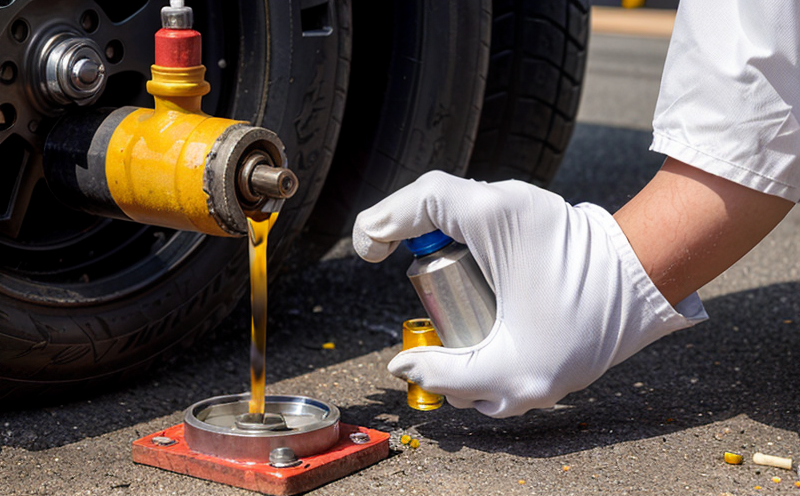ISO 3104 Kinematic Viscosity Testing of Petroleum Products
The ISO 3104 standard specifies the procedure for determining the kinematic viscosity of petroleum products by means of a capillary viscometer. This test is crucial in ensuring that lubricants, fuels, and other petroleum-derived substances meet quality standards necessary for safe and efficient operation across various industries.
The process involves measuring how quickly a liquid flows through a calibrated glass capillary tube under controlled conditions. The result provides valuable information about the fluid's resistance to flow, which is critical in selecting appropriate lubricants or fuels for specific applications. This test ensures that products perform optimally in their intended environments.
In marine and ship equipment testing, accurate viscosity measurements are essential because they directly impact engine performance and longevity. Viscosity affects how well a lubricant coats moving parts, reducing wear and tear over time. For fuels, the correct viscosity can ensure proper atomization during combustion, enhancing efficiency and minimizing emissions.
The precision of ISO 3104 testing is critical for quality managers and compliance officers. It helps maintain consistent product quality across production batches and ensures that manufacturers adhere to international standards like ISO and ASTM. This standard also supports R&D engineers in their efforts to innovate, as they can rely on accurate data from this test.
Testing begins with preparing the sample according to the specified procedure outlined in ISO 3104. Proper specimen preparation ensures reliable results that are representative of the actual product. Once prepared, the sample is carefully measured and poured into a capillary viscometer. The device is then placed in an incubation bath at precisely controlled temperature.
The measurement process involves recording the time it takes for a fixed volume of liquid to flow through the capillary tube under constant pressure. This time measurement, combined with known physical constants, allows calculation of kinematic viscosity. It’s important that all steps are conducted under strict conditions to avoid any deviation from standard procedures.
Once testing is complete, detailed reports are generated following ISO 3104 guidelines. These documents include all relevant data points such as temperature during measurement, viscometer type used, and calculated viscosity values along with their uncertainties. The report also provides insights into the suitability of the product for its intended use.
Accurate kinematic viscosity testing is not just about compliance; it plays a vital role in sustainability efforts by promoting efficient resource usage. By ensuring that lubricants and fuels have optimal viscosities, industries can reduce waste and improve overall operational efficiency. For example, in marine applications, using correctly viscous oils helps extend the life of engines while minimizing fuel consumption.
- Reduces Resource Waste: Properly tuned lubricants enhance equipment longevity, reducing the need for frequent replacements.
- Enhances Efficiency: Correct fuel viscosity optimizes combustion processes, leading to better performance and lower energy costs.
- Promotes Cleaner Operations: Lower emissions result from optimized operation, contributing positively to environmental goals.
Benefits
The benefits of ISO 3104 kinematic viscosity testing extend beyond mere compliance with industry standards. It offers several advantages that are crucial for maintaining high-quality petroleum products:
Quality Assurance: By consistently meeting the specified parameters, manufacturers can ensure their products meet or exceed customer expectations.
Cost Efficiency: Properly tuned lubricants and fuels lead to reduced maintenance costs and increased operational efficiency. This translates into lower overall expenditures for businesses operating within these sectors.
Environmental Impact: Reduced resource waste, minimized emissions, and enhanced performance contribute positively towards sustainable practices.
Eurolab Advantages
At Eurolab, we pride ourselves on delivering comprehensive testing solutions that cater specifically to the unique needs of our clients. Our team of experts ensures accurate and reliable results through meticulous adherence to international standards.
- Accurate Measurements: Utilizing state-of-the-art equipment calibrated according to ISO specifications guarantees precise readings.
- Comprehensive Reporting: Tailored reports provide in-depth analysis, including detailed explanations and recommendations for improvements if necessary.
- Experienced Personnel: Our staff holds extensive experience in marine and ship equipment testing, ensuring thorough understanding and execution of the ISO 3104 procedure.
We offer flexible service packages that can be tailored to meet individual client requirements. Whether you require periodic assessments or one-off tests, our team is committed to providing exceptional service every step of the way.





